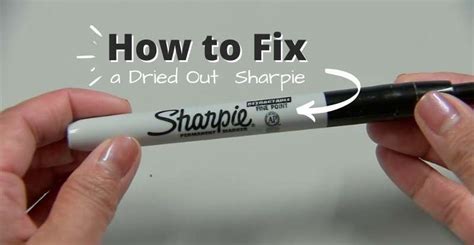Sharpies, those ubiquitous markers that grace our desks and backpacks, often serve as our dependable writing companions. However, even the most faithful Sharpies can occasionally falter, leaving us with smudged lines and frustrating streaks. Don’t despair! With a few simple techniques, you can resurrect your seemingly defunct Sharpie and restore it to its former glory.

Diagnosing the Problem
Before attempting repairs, it’s crucial to identify the root of the problem. Common Sharpie ailments include:
-
Dried-up ink: This occurs when the marker is left uncapped for an extended period, allowing the ink to evaporate.
-
Clogged tip: The tip may become blocked by dried ink or debris, preventing ink from flowing smoothly.
-
Broken valve: A defective valve inside the marker can hinder ink flow, resulting in a weak or intermittent output.
Remedies for Dried-Up Ink
-
Alcohol Immersion: Submerse the marker tip in rubbing alcohol for a few hours. The alcohol will dissolve the dried ink, allowing it to flow freely again.
-
Warm Water Bath: Dip the marker in a cup of warm water for 15-20 minutes. The heat will help soften the dried ink and facilitate its removal.
-
Blow Dryer Technique: Use a blow dryer to gently heat the marker tip. The warmth will soften the ink and encourage it to flow.
Remedying Clogged Tips
-
Needle Cleaning: Carefully insert a fine needle into the marker tip to dislodge any obstructions. Use a gentle touch to avoid damaging the tip.
-
Warm Water Flush: Fill a bowl with warm water and repeatedly dip the marker tip in and out. The water pressure will help flush out any debris or dried ink.
-
Vinegar Solution: Mix equal parts white vinegar and water in a bowl. Dip the marker tip into the solution for 10-15 minutes to dissolve any ink buildup.
Troubleshooting Broken Valves
-
Valve Mechanism Repair: If you suspect a broken valve, gently tap the marker several times against a hard surface. This may dislodge any stuck parts and restore the valve’s functionality.
-
Contact Manufacturer: If all else fails, contact the Sharpie manufacturer. They may be able to provide replacement parts or guidance on repairing the valve.
Additional Tips for Sharpie Longevity
-
Proper Capping: Always cap the marker immediately after use to prevent ink from drying out.
-
Storage Conditions: Store Sharpies in a cool, dry place away from direct sunlight. Heat and moisture can damage the ink.
-
Regular Use: Frequent use helps prevent ink from drying out and clogging the tip.
Innovative Applications for Sharpie Markers: Embracing the “Sharpisk”
Beyond their traditional writing and drawing purposes, Sharpies have inspired a plethora of inventive applications, showcasing the versatility of this ubiquitous tool.
“Sharpisk” Techniques:
-
Permanent Fabric Dyeing: Use Sharpies to create vibrant and permanent designs on fabrics, such as clothing, curtains, and tablecloths.
-
Custom Ceramic Art: Decorate ceramic pieces with Sharpie designs and bake them in an oven to create durable, personalized artwork.
-
Jewelry Making: Create earrings, pendants, and other jewelry pieces by drawing intricate designs on shrinkable plastic and heating it to shrink and solidify the design.
-
Glass Painting: Paint decorative designs on glass surfaces, such as windows, glassware, and mirrors, using Sharpies for vibrant and long-lasting results.
Conclusion
Restoring a Sharpie to working order is a simple and rewarding task. By understanding the common problems and applying the techniques described above, you can breathe new life into your trusty marker and continue expressing your creativity or completing essential tasks.
Remember to properly care for your Sharpies to ensure their longevity and embrace the “Sharpisk” possibilities to explore new and exciting applications.
